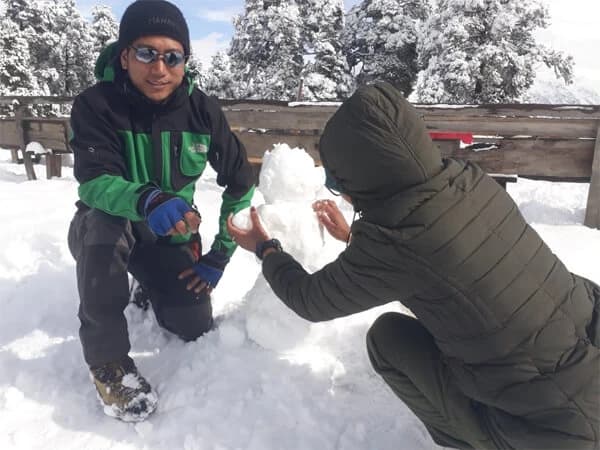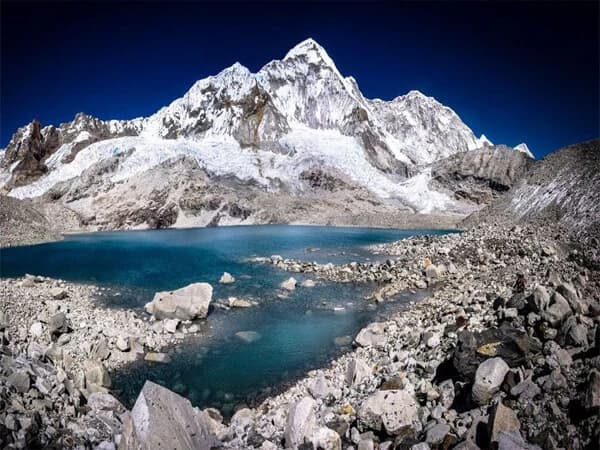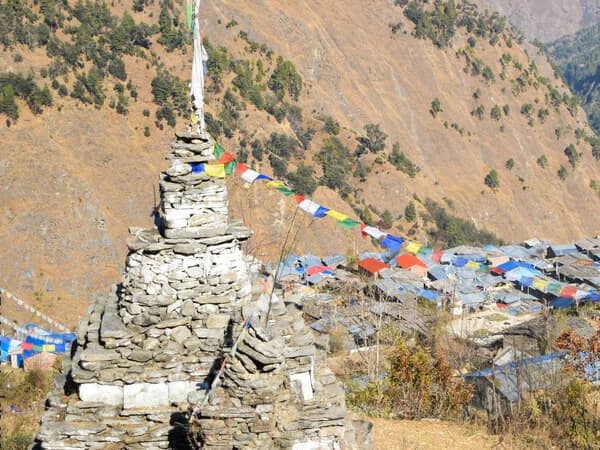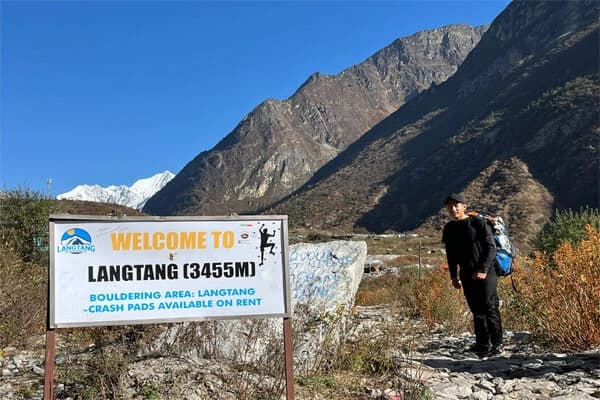The best time for langtang valey trek is during the Spring (March to May), and autumn (September to November) season. This month offer perfect pleasand temperatures, stunning views of himalaya peak, clear skies and blooming rhododendrons. The trek offers a stunning view of the mountain peaks of the Langtang Himalayan Range which includes Langtang Lirung (7,246m), Langtang II (6,581m), Kimshung (6,781m), Yansa Tsenji (6,575 m) and Mt. Dorje Lakpa (6,966m). During the trek, you will pass through the charming villages of the native Sherpa and Tamang communities. The Tamang Heritage Trek is the modification of the Langtang Valley trek where you can experience the lifestyle culture and traditions of the Tamang Community.
This trek can be done as a single trek, or combined with the Tamang Heritage trek, or as an acclimatization trek before attempting one of the more challenging treks like the Everest Base Camp Trek or the Annapurna Base Camp Trek.
Some of the highlights of this trek are as follows:
Stunning views of snow-capped peaks
One of the major highlights of this trek is the stunning views of the snow-capped peaks of Langtang, Ganesh Himal, and Manaslu region.
Langtang National Park
You can explore the rich bio-diversity of the region in the Langtang National Park. It is the first Himalayan National Park. The expansive high meadows provide summer habitat for numerous species like musk deer and Himalayan Thar. It is also known for its populations of red panda, Himalayan black bear, snow leopard, wild dog, and more than 250 species of birds.
Tamang Cultural Heritage
One of the highlights of this trek is the Tamang communities of Langtang Valley. You can explore the culture, tradition, and livelihood of these indigenous people.
Kyanjin Gompa
Kyanjin Gompa is an ancient Buddhist monastery where you can feel peace and tranquility.
Kyanjin Ri (4,600m)
You can summit Kyanjin Ri for the beautiful sunrise view of the Langtang Himalayas. It is the best vantage point for the Langtang region trek.
Importance of choosing the right time for trekking
Choosing the right time for the Langtang Valley trek is crucial for an enjoyable and safe experience. The Langtang region is known for its stunning landscapes and vibrant Tamang culture. It offers vastly different trekking conditions depending on the season.
In spring, the trails come alive with blooming rhododendrons and the weather is mild. It is an ideal season for clear mountain views and comfortable trekking in Nepal. Similarly, autumn offers stable weather with crisp skies, perfect for photography and a pleasant trekking experience.
Trekking in summer poses challenges due to heavy monsoon rains, which make the trails slippery and increase the risk of landslides. Winter brings extreme cold and snow at higher altitudes, limiting accessibility on the trail.
Timing impacts your interaction with local communities and the chance to experience cultural festivals. During peak seasons, you can engage more with fellow trekkers and locals. You can explore more deeply about the culture and traditions. Choosing the right time not only maximizes the beauty of the Langtang Valley but also ensures safety, comfort, and an unforgettable journey in the Himalayas.
Langtang Valley Trek in Spring Season (March-May)
Weather conditions
Spring starts in March and ends in May. It is one of the best seasons to trek the Langtang Valley. As the winter fades, the trails come alive with blooming rhododendrons and vibrant greenery. It creates a vibrant backdrop to the majestic snow-capped peaks. The weather is stable with clear mornings and cloudy afternoons.

Daytime temperatures at lower elevations range from 10°C to 20°C, while nights can dip to around 0°C. At higher elevations, daytime temperature stays cooler ranging from 5°C to 10°C, while nights can get colder dropping to -5°C.
Rainfall is minimal in early spring, ensuring clear skies and unobstructed views of snow-capped peaks like Langtang Lirung and Dorje Lakpa. As the season progresses into May, pre-monsoon showers may occur occasionally in the evenings. This adds freshness to the trails without major disruptions.
Wind conditions are mild and safe for trekking. The weather is predictable and pleasant for longer trekking days which is ideal for reaching key destinations like Kyanjin Gompa or Tserko Ri.
Hence, spring is a favorite among trekkers for scenic views and comfortable weather conditions. It enhances the trekking experience and supports acclimatization. This ensures a safer and more enjoyable journey through the Langtang Valley.
Pros and cons of trekking in spring
Pros
Stunning Natural Beauty:
Spring transforms the Langtang Valley into a paradise. The forests along the trails are covered by blooming rhododendrons, magnolias, and other wildflowers. It creates a picturesque scenery perfect for photography. The lush greenery and snow-capped peaks offer breathtaking contrasts.
Pleasant Weather:
The mild temperatures during the day make trekking comfortable. Also, stable weather conditions reduce the chances of disruptions. Clear skies offer uninterrupted views of the majestic Himalayas.
Cultural Immersion:
Spring is a vibrant time in the Langtang region. The locals are engaged in farming and celebrating festivals. It is a great opportunity to interact with the Tamang community and experience their unique traditions.
Peak Season Amenities:
Teahouses and lodges operate at full capacity during spring. There is availability of food, accommodation, and other services. The trails are lively with fellow trekkers, enhancing a sense of friendship.
Wildlife Sightings:
Spring is ideal for spotting wildlife in the Langtang National Park. You may see red pandas, langurs and various bird species.
Cons:
Crowded Trails:
Spring is a peak trekking season. The trails, teahouses, and key viewpoints get crowded. This may reduce the chance of getting solitude and a peaceful atmosphere.
Higher Costs:
Due to high demand, prices for accommodations, food, and guide services may increase in spring. Advanced booking is often necessary.
Pre-Monsoon showers:
Rainfall is rare in early spring. However, there can be occasional rain in May. This makes the trail slippery and requires extra caution.
Altitude Risks:
There can be risks of altitude sickness if you ascend too quickly. Acclimatization is essential despite the favorable weather.
Environmental Impact:
Increased numbers of trekkers during peak season can lead to trail degradation and waste problems. This may affect the natural beauty of the area. Although spring has its challenges, the pros far outweigh the cons for trekkers looking to experience the Langtang Valley at its best.
Popular activities and events during spring
Rhododendron Festivals and Spring Blossoms
In spring, the Langtang Valley bursts into color, with vibrant rhododendron forests covering the trails. Some local communities celebrate festivals tied to the blooming season. Visitors are allowed to take part in the traditional dances and feasts.
Trekking Highlights:
The Langtang Valley is the main area of activity with iconic stops like Kyanjin Gompa and Tserko Ri. Trekkers can explore glacial rivers, alpine meadows, and yak pastures. They offer a distinct springtime allure. You can hike around Kyanjin Gompa and enjoy the panoramic views of the surrounding peaks.
Cultural Festivals:
Spring often coincides with significant festivals like Tamang Lhosar (New Year) or Buddha Jayanti depending on the lunar calendar. These celebrations provide an opportunity to witness traditional Tamsng rituals, Buddhist prayers, and cultural performances.
Wildlife Exploration:
Spring is ideal for spotting wildlife in the Langtang National Park. Trekkers can join guided tours to observe rare species like red pandas and Himalayan monals in their natural habitats.
Photography and Relaxation:
The clear skies and vivid landscapes during spring are a haven for photographers. You can either capture a sunrise at Tserko Ri or candid village life. This season offers endless opportunities for stunning shots.
With its vibrant nature, cultural richness, and adventure-filled activities, spring is a magical time to experience the Langtang Valley.
Langtang Valley Trek in Summer Season (June-August)
Weather conditions
Summer starts from June to August in the Langtang Valley. It coincides with monsoon season. During this time, the region gets heavy rainfall with occasional breaks of clear skies in the mornings.
Daytime temperatures range between 15°C to 20°C at lower altitudes while at higher altitudes it ranges between 5°C to 10°C. Nights remain cooler, but not as cold as in other seasons as the temperatures rarely drop below freezing. The humidity levels are high, making the atmosphere moist and dense.
Rainfall is frequent and heavy in the evenings and nights. Trails can become muddy and slippery, increasing the difficulty of trekking. Streams and rivers swell. Visibility is reduced due to fog and cloud cover, so the views of the surrounding peaks are limited.
Despite these challenges, the landscape becomes lush and vibrant. The blooming wildflowers and dense greenery add unique charm to the trails. As fewer trekkers opt for summer treks, the atmosphere is serene and quiet.
While the summer offers its beauty, trekkers need to prepare for wet conditions. There can be leeches and bugs in the lower altitude. There may be disruptions due to landslides or floods. Proper gear and a flexible itinerary are essential for navigating the unpredictable weather.
Pros and cons of trekking in summer
Pros:
Lush Greenery:
The monsoon rains rejuvenate the Langtang Valley, turning it into a lush green paradise. The vibrant landscapes, blooming wildflowers, and dense forests provide a unique trekking experience.
Fewer Crowds:
Summer is the off-season for trekking in Nepal. The trails and teahouses are quieter. This solitude is perfect for trekkers seeking a peaceful experience.
Cheaper Rates:
With fewer visitors, teahouses and guides often offer discounted prices on accommodations and services. This season is budget-friendly for trekking.
Cultural insights:
The quiet time allows for deeper interaction with the local Tamang and Sherpa communities. Monsoon farming activities provide a glimpse into the daily lives of the residents.
Photography opportunities:
The mist-covered trails, rain-soaked forests, and dramatic skies offer a unique photographic allure. You can have some moody atmospheric shots.
Cons:
Heavy Rainfall:
The monsoon season brings frequent and heavy rains. The trekking conditions are challenging. Wet clothes, damp gear, and waterlogged trails are common.
Trail Hazards:
Muddy and slippery paths increase the risk of falls. The swollen rivers and landslides can pose safety concerns and disrupt itineraries.
Limited Mountain Views:
Cloud cover and fog often obscure the majestic Himalayan peaks. Those hoping for clear vistas may get disappointed.
Leeches and Insects:
The humid conditions attract leeches and other insects in the forest areas. Trekkers can get annoyed by them.
Health Risks:
The damp environment increases the likelihood of colds, blisters, and other ailments. Proper waterproof gear and good hygiene practices are essential. Summer treks in Langtang Valley come with challenges. However, they also offer unique rewards for those prepared for the season.
Monsoon season and its impact on the Langtang trek
The monsoon season has a huge impact on trekking in the Langtang valley. The rains rejuvenate the landscape but also bring challenges that require careful preparation and flexibility.
Trail Conditions:
Heavy rains make trails slippery and muddy increasing the risk of accidents. Crossing swollen rivers or streams can be hazardous. Landslides may occasionally block paths, which may delay the trip and require rerouting. Trekkers should wear sturdy, waterproof boots and use trekking poles for added stability.
Mountain Views:

Cloud cover is a major drawback of trekking during the monsoon. Mornings offer brief windows of clear skies. Afternoons are often obscured by fog and rain. The visibility of the surrounding peaks like Langtang Lirung and Dorje Lakpa is limited.
Wildlife and Environment:
The monsoon enhances the valley’s natural beauty with flourishing greenery and abundant wildlife. The damp conditions in the forested sections bring leeches and other insects.
Safety and Preparation:
Monsoon trekking in Nepal demands extra precautions. Trekkers should carry rain gear, waterproof bags, and quick-drying clothing. Flexible itineraries are essential for weather-related delays. Hiring an experienced guide is recommended for navigating the unpredictable conditions.
Trekking to Langtang Valley during the monsoon is challenging. However, it offers a unique perspective of the vibrant ecosystem of the region for those prepared well and adaptable.
Langtang Valley Trek in Autumn Season (September-November)
Weather conditions
Autumn starts in September and ends in November. It is the most popular season for trekking in the Langtang Valley due to its ideal weather conditions. After the monsoon, the skies clear up, unveiling spectacular mountain views and vibrant landscapes.
Daytime temperatures at lower altitudes range between 10°C and 20°C making comfortable trekking. Higher altitudes, such as Kyanjin Gompa or Tserko Ri, experience cooler temperatures between 0°C and 10°C. Nights can be cold, with temperatures dropping below freezing at higher altitudes.
Rainfall is minimal, as the monsoon winds subside. The dry weather makes the trail stable and easier to navigate. Humidity levels are low, resulting in crisp fresh air and stunning visibility.
The long sunny days of the autumn season have pleasant temperatures. Trekkers can cover significant distances comfortably. The weather becomes colder toward the end of November marking the transition into winter.
Overall, the weather conditions in autumn are stable and mild. It is the best time to enjoy Langtang Valley’s breathtaking beauty, cultural richness, and well-maintained trails.
Pros and cons of trekking in autumn
Pros:
Spectacular Mountain Views:
Autumn offers crystal-clear skies with spectacular views of peaks like Langtang Lirung, Dorje Lakpa, and Ganesh Himal. It is a dream season for photographers and mountain enthusiasts.
Stable Weather:
The dry and mild climate ensures comfortable trekking conditions. There is minimal risk of rainfall or extreme temperatures. This stability allows trekkers to follow their itineraries without disruptions.
Vibrant Landscapes:
The post-monsoon season brings vibrant greenery, colorful forests, and clean and refreshed trails. The valleys look picturesque with a blend of natural beauty and tranquility.
Cultural Experiences:
Autumn coincides with major festivals like Dashain and Tihar. The trekkers get a chance to experience Nepal’s rich cultural traditions. The local Tamang community celebrates these festivals with unique rituals, dances, and hospitality.
Well-Serviced Trails:
Autumn is the peak trekking season. The teahouses, lodges, and guide services operate at full capacity. The trekkers have access to comfortable accommodations and well-prepared meals.
Trekking Companionship:
Due to the popularity of the season, there are more fellow trekkers on the trails. There are opportunities for shared experiences, networking, and friendship.
Cons:
Crowded Trails:
The influx of trekkers during autumn makes the trails, teahouses, and key viewpoints crowded. Those seeking solitude may find this aspect less appealing.
Higher Costs:
There is high demand during the peak season. The prices for accommodations, food, and guide services can increase too. Booking in advance is recommended.
Cold Nights:
At higher altitudes, daytime temperatures are comfortable but nights can be cold. Proper layering and good-quality sleeping bags are essential.
Overbooked Teahouses:
The popularity of the season can result in full teahouses in smaller villages. Late arrivals may struggle to find accommodation.
Environmental Impact:
The increase in trekking traffic increases the risk of trail degradation and waste issues. The pristine environment of the Langtang Valley may be affected. Autumn is the preferred season for trekkers despite the challenges. It offers unparalleled beauty, favorable conditions, and cultural richness.
Best time for clear views and comfortable trekking
The Mid-autumn period, from late September to early November, is ideal for the best views and trekking conditions in the Langtang Valley. This period offers the perfect balance of mild weather, stable trails, and breathtaking scenery.
In late September, the rains of the monsoon recede completely. The air is clean and the skies are free of haze. The surrounding peaks and valleys appear vibrant. These conditions are ideal for photography and sightseeing. Temperatures are mild. Trekkers can enjoy long comfortable days on the trail without excessive heat or cold.
October is considered the pinnacle of the trekking season. The weather remains stable, with sunny days and cool nights. This period is popular for ascents to viewpoints like Tserko Ri. You can view the panoramic vistas of the Langtang Himalayas from there. The trails are dry and well-maintained for safe and efficient trekking.
By early November, temperatures begin to drop at higher altitudes. The skies remain clear and the valley retains the charm of autumn season. This is an excellent time for those who prefer quieter trails as the season approaches its end.
Finally, the mid-autumn period offers a combination of clear views, pleasant weather and cultural interactions. It is the best time to explore the Langtang Valley.
Langtang Valley Trek in Winter Season (December-February)
Weather conditions
The winter season starts from December to February. It brings a unique charm but also some challenges due to the cold and snowy conditions.
Daytime temperatures in the lower altitudes range between 5°C and 10°C. In higher altitudes, it ranges between -5°C to 5°C. Nights can be extremely cold above 3,000 meters with temperatures dropping below -15°C.
Snowfall is common in the higher altitudes covering the trails and peaks. The weather is dry and the skies remain clear. You can have stunning views of the surrounding mountains like Langtang Lirung and Ganesh Himal. The crisp air and low humidity enhance the visibility which is ideal for photography.
Despite the cold, the days are usually sunny and pleasant for trekking. Snow-covered trails can delay your journey. The high passes may become impassable due to heavy snow.
Winter trekking in the Langtang Valley is suitable for those seeking solitude and adventure. It requires proper preparation and the right gear. This season offer a magical trekking experience away from the crowds of peak seasons.
Pros and cons of trekking in winter
Pros:
Spectacular Views:
Winter provides the clearest skies of the year. It offers stunning views of the Langtang Himalayas and the surrounding valleys.
Peaceful Trails:
The off-season nature of winter trekking provides quiet trails and a serene atmosphere. It is perfect for those seeking solitude and tranquility.
Unique Landscape:
Snow transforms the Langtang Valley into a winter wonderland. The frozen streams, snow-covered forests, and glistening peaks create a magical setting.
Cultural Immersion:
With fewer trekkers around, winter offers more opportunities to engage with the local Tamang and Sherpa communities. You can learn about their traditions and winter lifestyle.
Lower Costs:
Accommodation and trekking services are often cheaper in winter. It provides a budget-friendly option for adventurous trekkers.
Cons:
Extreme cold:
The freezing temperatures at night can be challenging. Proper layering and high-quality sleeping bags are essential to bear the cold.
Snow-Covered Trails:
Snow can make trails slippery and difficult to navigate. It increases the risk of injury. High passes may become inaccessible requiring itinerary adjustments.
Limited Teahouse services:
Some teahouses in higher altitudes may close for the season. Accommodation and food options will be limited.
Shorter Days:
Winter days are shorter. It reduces the amount of time available for trekking each day. Early starts are crucial to make the most of daylight hours.
Isolation:
The lack of fellow trekkers can be isolating for those who enjoy the camaraderie of busy trails. Emergency assistance may take longer to arrive assistance may take longer to arrive. Winter trekking in Langtang Valley comes with significant challenges. The serenity and beauty of the season make it a rewarding experience for well-prepared adventurers.
Challenges and precautions for winter trekking
Challenges:
- Cold Temperatures: The extreme cold at night can lead to discomfort or even hypothermia if not prepared.
- Snow and ice: Snow-covered trails and icy patches increase the difficulty of trekking and the risk of slipping.
- Limited Accessibility: Heavy snowfall can block trails or block the high passes. It may require to change the planned route.
- Health Risks: The combination of cold temperatures and high altitude increases the risk of altitude sickness, frostbite and other cold related conditions.
- Resource Scarcity: Many teahouses close and there will be fewer trekkers on the trails. Finding accommodation and supplies can be more challenging.
Precautions:
- Gear Up: Invest in high-quality winter gear, including insulated jackets, waterproof boots, thermal layers, and sleeping bags rated for sub-zero temperatures.
- Trekking poles and Crampons: These are essential for maintaining stability on snow-covered and icy trails.
- Hire a Guide: An experienced local guide is invaluable for navigating snowy trails and managing unforeseen challenges.
- Check Weather Forecasts: Regularly monitor the weather to avoid trekking during storms of heavy snowfall.
- Acclimatization: Take time to acclimatize properly to reduce the risk of altitude sickness. Carry a first-aid kit and be aware of symptoms.
- Plan Flexibly: Be prepared to adjust your itinerary based on trail conditions and weather.
These challenges should be addressed with thorough preparation and caution. Then the trekkers can safely enjoy the beauty of the Langtang Valley in winter.
Factors to Consider When Choosing a Time
Selecting the right time for a trek is crucial for a fulfilling experience. Several factors matter including your personal preferences, comfort levels, crowd tolerance, budget constraints, and the specific activities or events you want to enjoy. Here’s how these factors can influence your decision:
Personal preferences and comfort level
Your preferred weather conditions, physical readiness, and tolerance for challenges will significantly impact your choice of timing. For example:
- Weather Conditions: If you thrive in mild, sunny weather, spring and autumn are ideal seasons. They offer stable conditions, clear skies, and comfortable temperatures. However, if you enjoy the solitude of snow-covered trails and are equipped to handle the cold, winter can be magical.
- Trail Difficulty: Some seasons, like monsoon season, have challenges with muddy and slippery trails. If you are an experienced trekker seeking adventure this might appeal to you. Beginners prefer easier seasons like spring or autumn..
- Altitude tolerance: Those new to high-altitude trekking might want to avoid colder months as extreme cold can cause altitude-related difficulties.
Crowds and peak season
The popularity of trekking seasons can greatly affect your experience.
Peak Seasons (Spring and Autumn):
These are the busiest times, with bustling trails and fully booked teahouses. The presence of fellow trekkers can be either uplifting or overwhelming depending on personal preferences.
Off-seasons (Winter and Monsoon):
During these periods, trails are quieter. You can have a peaceful journey. However, fewer trekkers also mean limited services as some lodges and guides may not operate during the low season.
Budget constraints
Your budget can also influence the timing of your trek. Costs can fluctuate in different seasons.
Peak season costs: Higher demand during spring and autumn often leads to increased prices for accommodations, meals, and guided services. Popular routes can also charge premium rates.
Off-Season Discounts: Winter and monsoon seasons usually offer reduced prices, as teahouses and trekking companies compete for fewer trekkers. This makes the off-season more budget-friendly.
Specific activities or events:
If there are particular activities or cultural experiences you wish to include, these should guide your timing:
- Seasonal Festivals: Trekking during festivals like Dashain or Tihar in autumn offers a chance to experience Nepal’s rich culture.
- Flora and Fauna: Spring is ideal for witnessing blooming rhododendrons and diverse wildlife. Monsoon brings vibrant greenery.
- Snow and Ice Experiences: Winter treks provide the thrill of navigating snowy trails and the serenity of frozen landscapes.
- Clear Mountain Views: For photography enthusiasts, autumn and late winter are excellent for capturing crystal-clear vistas of the Himalayas.
Conclusion:Best Time for Langtang Valley Trek
The Langtang Valley trek is an incredible journey that takes you to the closest Himalayan range from Kathmandu. Spring and autumn are considered the best times to trek due to the stable weather, comfortable temperatures, clear visibility, and popularity. Whereas, summer and winter are less popular due to difficult trail conditions, unpredictable weather, and poor visibility.
Choosing the right time to trek involves a careful balance of your personal preferences, tolerance for crowds, budget considerations, and the specific experiences you seek. Reflect on what matters most to you whether it is clear views, solitude, cultural immersion, or cost-efficiency. Then plan accordingly for an unforgettable adventure.











